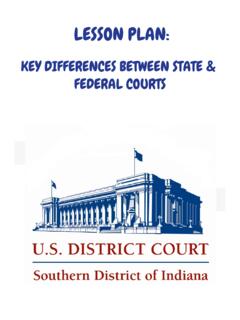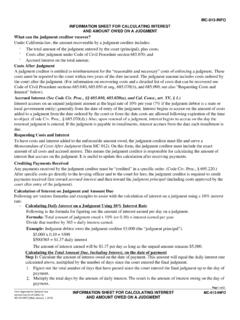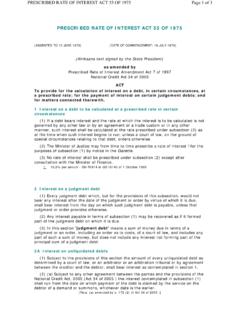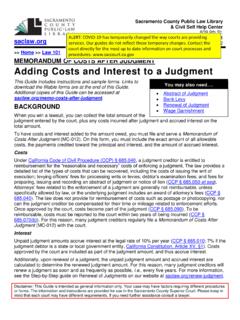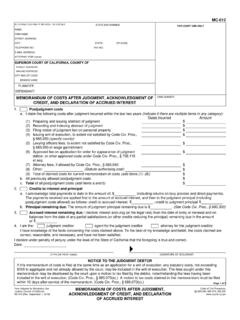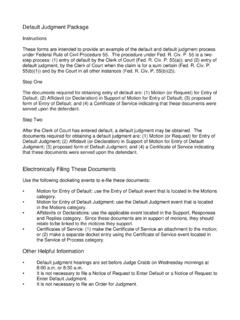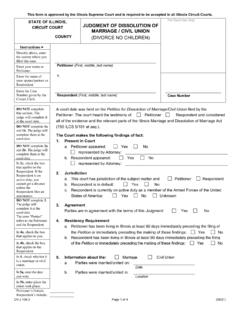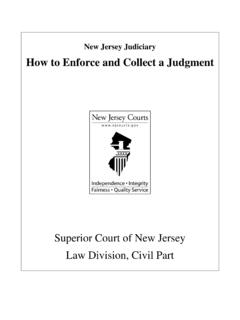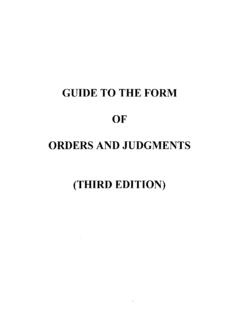Transcription of Local Rule 56-1 – Summary Judgment Procedure
1 Local Rule 56-1 Summary Judgment Procedure (a) Movant s Obligations. A party seeking Summary Judgment must file and serve a supporting brief and any evidence (that is not already in the record) that the party relies on to support the motion. The brief must include a section labeled Statement of Material Facts Not in Dispute containing the facts: (1) that are potentially determinative of the motion; and (2) as to which the movant contends there is no genuine issue. (b) Non-Movant s Obligations. A party opposing a Summary Judgment motion must, within 28 days after the movant serves the motion, file and serve a response brief and any evidence (that is not already in the record) that the party relies on to oppose the motion. The response must include a section labeled Statement of Material Facts in Dispute that identifies the potentially determinative facts and factual disputes that the party contends demonstrate a dispute of fact precluding Summary Judgment . (c) Reply. The movant may file a reply brief within 14 days after a response is served.
2 (d) Surreply. A party opposing a Summary Judgment motion may file a surreply brief only if the movant cites new evidence in the reply or objects to the admissibility of the evidence cited in the response. The surreply must be filed within 7 days after the movant serves the reply and must be limited to the new evidence and objections. (e) Citations to Supporting Facts. A party must support each fact the party asserts in a brief with a citation to a discovery response, a deposition, an affidavit, or other admissible evidence. The evidence must be in the record or in an appendix to the brief. The citation must refer to a page or paragraph number or otherwise similarly specify where the relevant information can be found in the supporting evidence. (f) Court s Assumptions About Facts. In deciding a Summary Judgment motion, the court will assume that: (1) the facts as claimed and supported by admissible evidence by the movant are admitted without controversy except to the extent that: (A) the non-movant specifically controverts the facts in that party s Statement of Material Facts in Dispute with admissible evidence; or (B) it is shown that the movant s facts are not supported by admissible evidence; or (C) the facts, alone or in conjunction with other admissible evidence, allow the court to draw reasonable inferences in the non-movant s favor sufficient to preclude Summary Judgment .
3 (2) facts that a non-movant asserts are true to the extent admissible evidence supports them. (g) Stipulation to Facts. The parties may stipulate to facts in the Summary Judgment process, and may state that their stipulations are entered only for the purpose of the motion for Summary Judgment and are not intended to be otherwise binding. (h) No Duty to Search Record. The court has no duty to search or consider any part of the record not specifically cited in the manner described in subdivision (e). (i) Collateral Motions. The court disfavors collateral motions such as motions to strike in the Summary Judgment process. Any dispute over the admissibility or effect of evidence must be raised through an objection within a party s brief. (j) Oral Argument or Hearing. The court will decide Summary Judgment motions without oral argument or hearing unless the court otherwise directs or grants a request under Ind. 7-5. (k) Notice Requirement for Pro Se Cases. A party seeking Summary Judgment against an unrepresented party must file and serve the notice contained in Appendix A.
4 (l) Compliance. The court may, in the interest of justice or for good cause, excuse failure to comply strictly with this rule. Local Rules Advisory Committee Comments Re: 2002 Amendment The 2002 revision completely replaces the former rule. It is designed to reduce the length of briefs related to motions for Summary Judgment , particularly the statement of undisputed material facts. In some cases, the statement of undisputed material facts has grown to an unmanageable level for the courts and for the parties. The parties have included facts which are not material to the legal issues to be resolved by Summary Judgment . Including the statement of undisputed material facts in the 35-page limit for initial briefs established by Ind. L. R. (b) will require the parties to discipline their presentation. Note to subdivision (a). This provision sets forth the general requirements for all briefs to be submitted by the parties. It requires that the movant s brief contain a Statement of Material Facts Not in Dispute.
5 Emphasis is made that material facts are ones which are potentially determinative (former Rule (h)). The Statement should not contain mere background facts which a party feels puts the case in perspective that can be done in an introduction or background section of the brief. Further, the Statement of asserted material facts is to state facts, not the party s argument which should be in the argument portion of the brief. Asserted material facts must be supported by specific citations to the admissible evidence in the record, which requires that any material not already in the Court s file be contained in an appendix. Although the strict formatting requirements of former Rule (h) are eliminated, separately numbering the facts is recommended for presentation clarity. Note to subdivision (b). The specific rules for the non-movant s response are contained in this section. The brief shall contain a Statement of Material Facts in Dispute identifying: (1) the material facts which preclude Summary Judgment and/or (2) disputed material facts which do so.
6 Like movant s Statement, the non-movant s Statement should not contain mere background facts or be argumentative. Note to subdivision (d). A non-moving party may file a surreply brief in two limited circumstances. It is permitted only when: (1) the moving party submits in its reply brief evidence not previously cited; or (2) the moving party objects in its Reply to the admissibility of evidence cited by the non-movant. Note to subdivision (e). This provision sets forth the effect of facts asserted. If supported by cited admissible evidence, a party s asserted material facts will be assumed admitted unless the opposing party submits admissible evidence of a genuine issue of material fact, demonstrates that the movant s assertions are not supported by admissible evidence or, through argument, shows that reasonable inferences can be drawn from admissible facts which preclude Summary Judgment . Obviously, the parties may, and are encouraged to, stipulate to undisputed material facts.
7 Any such fact stipulations may be for purposes of the Summary Judgment motion only. The Court will not search the record to find admissible evidence to support an asserted material fact. Note to subdivision (f). Motion practice about the admissibility of evidence cited in support of asserted material facts is strongly discouraged. Challenges to the evidence belong in the parties briefs. Cross Motions. If the parties anticipate cross-motions for Summary Judgment , the briefing schedule and format should be addressed in the case management plan.

